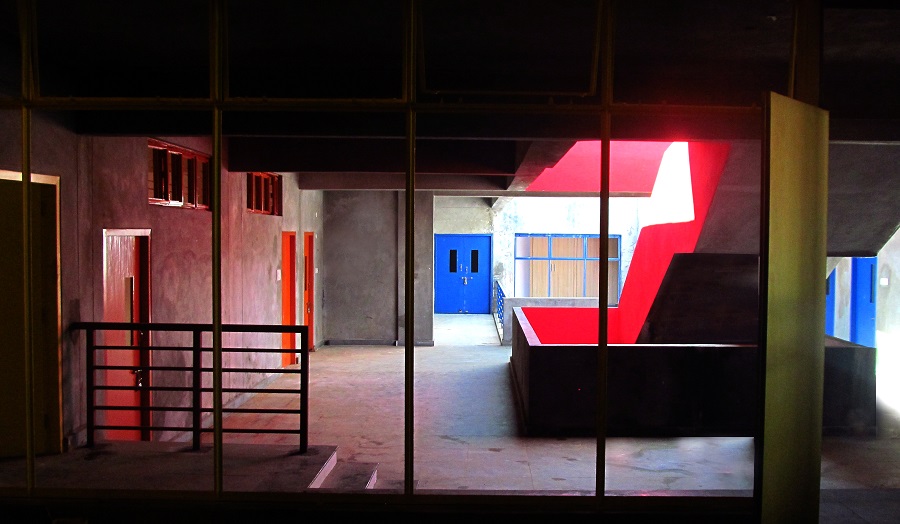Welcome to Part 9 of the Firm of Her Own Series, which highlights the career of architect Takbir Fatima. This series is dedicated to all of the women in architecture who commit to providing superior services and work diligently to make their mark. You can visit our profiles of Maya Lin, Angela Brady, Zaha Hadid, Beverly Loraine Greene, Anna Puigjaner, AMI Mastermind members Aparna Patil and Cinda Lester, AMI Mastermind Alumni Giusi Mastro and Co Govers — wonderful examples of marketing for female architects.

What's special about the time and place where you grew up?
I’m from India but I grew up in Al-Khobar, Saudi Arabia, where I lived till I was 17. My hometown was by the sea, well-connected to other ports and closer to surrounding countries in the Gulf than to other cities in Saudi Arabia. It’s a very cosmopolitan place, with expatriates from all over the world. I was fortunate to have made friends from many different countries and cultures, and to learn a little bit about their backgrounds and languages and stories of vacations in their native countries. Al-Khobar is a very new city, but I was able to travel all over the country, especially to Mecca where I saw a rich and layered history in the urban fabric, which really interested me. Later I would learn that the study of architecture encompasses learning about people, place and time.
What were some of the obstacles or challenges? What was your path in college & architecture school and what led you there?
Having lived in a place all your life and yet not being a native or citizen comes with a unique set of challenges and insecurities. Living as an expatriate NRI (non-resident Indian) in Saudi Arabia meant that I was a nomad, torn between my home (ie. Saudi Arabia and my native country, ie. India). In many ways I was an outsider and didn’t feel like I belonged to either place completely. One major obstacle I faced in Saudi Arabia was that I had led a very protected life, which was also privileged in many ways. I wanted to break out of my shell and explore the world, to live what I thought was the “real life” with real problems and challenges. Whenever I visited India, I saw the very real problems that needed solving and that I could learn from, and I decided to go to college here instead of in the Middle East. This would also help me get in touch with the other side of my own history, and learn about my family background and culture.
Going to college in India and living here has been very rewarding to me personally, because I am no longer remote and on the outside looking in at the very pressing issues that affect many people living here, such as population density, accessibility to education, resources and infrastructure, political uncertainty, and cultural practices. India is a very ancient civilization with layers of history and cities that date back hundreds of years. At the same time, I was living in Hyderabad, a metropolitan city that had evolved over hundreds of years and is now a bustling and quickly-growing city. It is more of a challenge working in such situations and designing in contexts that have multiple constraints as opposed to a clean slate or “tabula rasa” where everything is ordered. I find I always enjoy working within constraints and I believe that gives birth to creativity.
Tell me about starting your professional journey and starting your firm – why, to what purpose?
I always aimed to start my own firm, but after I completed my undergrad, I began to feel like this was just the beginning of the journey, there was lots more to learn and I had only just scratched the surface of what being an architect was all about. I also found architecture school severely lacking in the understanding of how to set up and run and independent practice. We are all taught to aspire to become practicing architects (a stance that I don’t agree with, as there are so many different ways to be an architect) and yet we are ill-equipped in mapping out ways to generate work, to reach potential clients, to negotiate, to hire and train a team, etc.
I will say that undergraduate architectural education, especially in most schools in India, is also being left behind when it comes to learning the significance of technology and what a critical role it will play in our profession in the near future. This is why I decided to pursue my Master’s at the AA School of Architecture in London, an avante garde school that is at the forefront of innovation in education, research and practice. The program I attended is called the Design Research Lab, and it is diametrically opposite to anything I learned in undergrad.
This is where I began to understand the importance of a formulating a personal stance and agenda; it had to be far more than describing myself as a rebel or outlier, which is what I had seen myself as until then. The program was very open-ended and experimental, and there was no clear right or wrong path. I began to take an exploratory approach to my work and plans, and I started DesignAware while I was at the AA.
I wanted to make good design accessible and ubiquitous, and returning to India allowed me to serve communities that needed design intervention the most. I’m not very much drawn towards designing for the elite sections but I am passionate about making design available and accessible. I believe India is the best playground for a designer who thrives in a messy, self-organized, flexible, informal, rule-bending environment.
What is your personal mission?
My foremost aim is to create awareness about design and its importance. Only then will people understand the role of an architect and how crucial it is to invest in consulting an architect for their projects. Of course I want to design buildings and spaces and objects. That’s the main reason I became an architect, to be able to fulfill my desire to keep experimenting, designing and innovating. If you love your work, it feels like a privilege to be able to do it everyday. I am also passionate about socially-relevant design that serves communities, and I devote some of my time and resources to this end.
What are the highlights of your/your firm’s accomplishments?
I have been fortunate to work on very interesting projects that really excite us. Each project is unique and has its own peculiarities, which allowed us to come up with unconventional responses.
In the last five years, we have won multiple awards for our work, including me being named NDTV Emerging Architect of the Year 2016, Telangana Young Architect 2016 and being included in the iGen 50 in 2019, a list of emerging architects and designers in India. I have also had the opportunity to be a part of Dubai Design Week 2018 and Hyderabad Design Week 2019 as well as the 31st World Design Assembly. In addition, I have been invited to share my work and methods at various events and platforms, such as TEDx and most recently in the Virtual Design Festival by Dezeen.
Is there a ‘feel’ that is common to all your built designs?
Our firm is still very young, in architects’ years. So we’re still experimenting with different styles and materials and approaches. I don’t think we have a defining style as yet. We do have an inclination towards geometry and formal experimentation. Given that most of our projects are in India and in very tight contexts, the common factor is the response to existing constraints and creatively solving problems on site.
How do you communicate this in your marketing?

Hilltop School (Photography by Akhila Rao and Ujjwal Sannala), DesignAware / Architect Takbir Fatima.
Right at the beginning of starting and setting up my firm, I joined the Startup Leadership Program, which is a worldwide peer-to-peer learning network that really helped me understand the business side of being an independent practitioner. I knew it was important to see the practice as a startup and I’ve always been very clear about the fact that it’s not just a practice or a design studio but aspires to be a business as well. I’ve been a follower of multiple podcasts and publications about the business of architecture and marketing techniques since the beginning.
I learned that the narrative is of utmost importance. Just like people want to know the story behind every project and built space, they also like to know the story and the motivations as well as the obstacles behind every company or brand. Having an accessible narrative and strong and honest personal branding is what makes a professional or a design studio relatable. We make sure that each member of our team is seen and has a voice. We also make it evident that we understand the issues and apprehensions that clients face before, during and after their project, and try to address them, which builds trust, the very foundation of any good professional relationship.
I like to think I’m a pretty good storyteller, and I make use of all the channels available today to reach potential clients or just design enthusiasts. We have an infrequent newsletter that talks about our design processes and tells stories about our experiences with different projects, and we frequently take our followers through our day and into our studio on Instagram stories, which makes them get an inside look into our work and process. Our posts also aim to be interactive and engaging.
We are fortunate to be in such a time when we can self-publish our work online, which gives us as much exposure as larger firms and puts us on the same platform. Young architects should make use of this opportunity and have their own websites and social media, and start to build their personal brand early on, which many are already doing.
How has being a female architect impacted your professional relationships and your life as a whole?
This question perplexes me, possibly because I may not be astute enough to have noticed gender bias or discrimination. I’ve always been a multi-layered minority, so it gets very difficult to pinpoint the exact reason why certain situations or behaviors have occurred. This is not to undermine or minimize the many struggles of women in all professions all over the world. Gender disparity is a very real issue, and I am sure it has a role to play in the absence of women in the profession, especially in high positions, and especially since more than half of the class consists of women in undergraduate architecture programs.
Personally, I haven’t faced too many issues being a female architect. When I was just starting out there were some power struggles on site and overbearing men I had to associate with professionally. However, I attribute this more to ageism than to sexism, because older and experienced architects are more respected and listened to. Almost all the people I worked with in teams I was leading were older than me, and it is certainly difficult taking directions from a younger person, no matter how educated they may be.
Indeed. If we fast forward to age 100, what do you want to known for in your work?
I would like to be known for work that was brave and experimental, but also humane and inclusive. It is important to me that the experience of architecture is rewarding to those using it or going through it, as well as the impact it has on the greater context. If our work lasts for that long, I believe we’ll have done something right.
